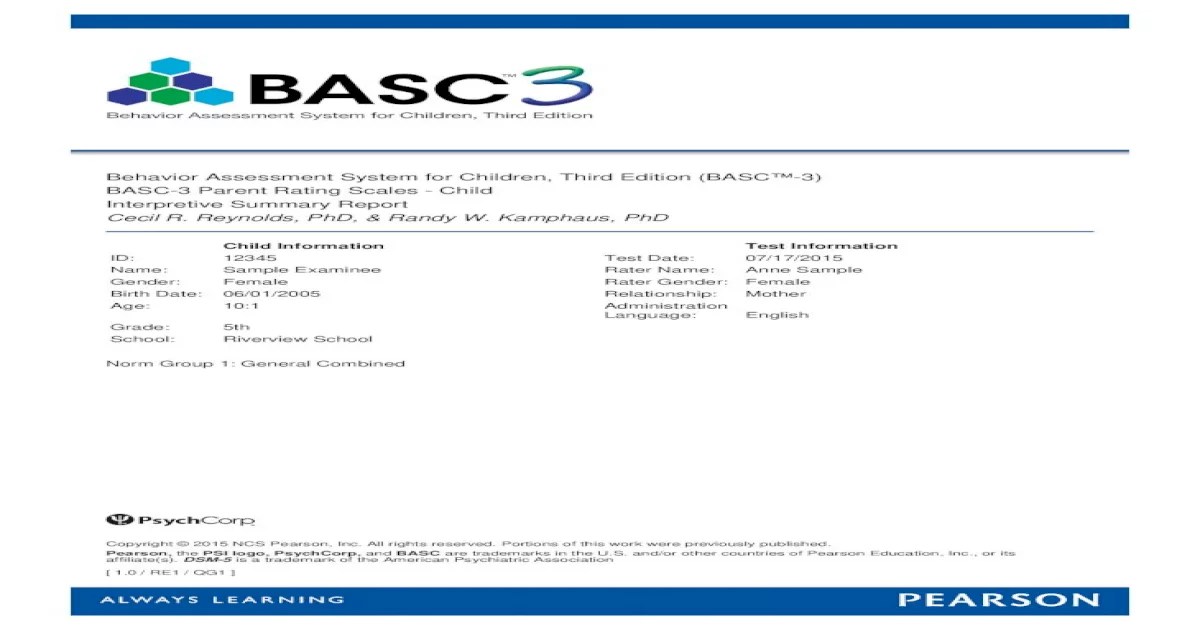Behavioral symptoms index basc 3 – The Behavioral Symptoms Index (BASC-3) emerges as a highly acclaimed assessment tool, meticulously crafted to unravel the intricacies of behavioral and emotional health. This third iteration of the BASC family builds upon a rich legacy of research and clinical applications, offering a comprehensive window into the complexities of human behavior.
As we delve into the depths of the BASC-3, we uncover its robust structure, encompassing diverse sections and scales that meticulously capture a wide spectrum of behavioral symptoms. Its hierarchical organization provides a nuanced understanding of individuals’ strengths and challenges, catering to a broad range of age groups and populations.
Behavioral Symptoms Index (BASC-3) Overview
The Behavioral Symptoms Index (BASC-3) is a comprehensive assessment tool designed to evaluate behavioral and emotional problems in children and adolescents. It provides a detailed profile of an individual’s strengths and weaknesses, helping clinicians and educators make informed decisions about diagnosis, treatment, and intervention strategies.
History and Development
The BASC-3 was developed by Thomas Achenbach and Craig Edelbrock in 1991 and has undergone several revisions since then. The current version, BASC-3, was released in 2001 and incorporates the latest research on child and adolescent psychopathology.
Theoretical Framework and Psychometric Properties
The BASC-3 is based on the multiaxial diagnostic system used in the Diagnostic and Statistical Manual of Mental Disorders (DSM-5). It assesses a wide range of behavioral and emotional problems, including internalizing disorders (e.g., anxiety, depression), externalizing disorders (e.g., aggression, oppositional defiant disorder), and adaptive functioning (e.g.,
social skills, academic performance).
The BASC-3 has strong psychometric properties, including high reliability and validity. It has been widely used in research and clinical settings and has been translated into over 40 languages.
BASC-3 Structure and Components

The BASC-3 consists of multiple sections and scales, each designed to assess specific aspects of behavior. The scales are organized into a hierarchical structure, with higher-order scales representing broader behavioral domains and lower-order scales representing more specific behaviors.
Sections and Scales
- Parent/Teacher Rating Scales:These scales are completed by parents or teachers and provide information about the child’s behavior in different settings.
- Self-Report Scales:These scales are completed by the child or adolescent themselves and provide information about their own perceptions of their behavior.
- Clinical/School Observation Scales:These scales are completed by a trained observer and provide information about the child’s behavior in a clinical or school setting.
Hierarchical Structure
The BASC-3 scales are organized into a hierarchical structure, with higher-order scales representing broader behavioral domains and lower-order scales representing more specific behaviors. The highest-order scale is the Global Composite Scale, which provides a general overview of the child’s overall behavioral functioning.
Below the Global Composite Scale are four broad-band scales: Internalizing Problems, Externalizing Problems, Behavioral Symptoms Index, and Adaptive Skills. Each of these scales represents a different aspect of the child’s behavior, such as emotional problems, conduct problems, or social skills.
Beneath the broad-band scales are a number of narrower-band scales that provide more specific information about the child’s behavior. For example, the Internalizing Problems scale includes scales such as Anxiety, Depression, and Somatization.
Age Ranges and Populations
The BASC-3 is appropriate for use with children and adolescents aged 2 to 18 years. It can be used to assess a wide range of behavioral problems, including anxiety, depression, conduct problems, and social skills deficits.
Administration and Scoring of the BASC-3
The BASC-3 is administered to individuals aged 2 to 18 years old. It can be administered by a qualified mental health professional, such as a psychologist or counselor. The administration time varies depending on the age of the individual and the number of forms being administered, but it typically takes around 45-60 minutes.The
BASC-3 is scored using a standardized scoring system. The raw scores are converted into T-scores, which have a mean of 50 and a standard deviation of 10. The T-scores are then used to generate a profile of the individual’s strengths and weaknesses.
Clinical Applications of the BASC-3
The BASC-3 is a versatile tool that has numerous clinical applications in various settings. It is widely used by mental health professionals, such as psychologists and psychiatrists, to assess behavioral and emotional problems in children, adolescents, and adults.The BASC-3 can be used for a range of purposes, including:
- Diagnosis:The BASC-3 can assist in diagnosing various mental health disorders, such as anxiety, depression, attention deficit hyperactivity disorder (ADHD), and autism spectrum disorder (ASD).
- Treatment planning:The BASC-3 can help clinicians develop individualized treatment plans by identifying specific areas of concern and setting appropriate goals.
- Progress monitoring:The BASC-3 can be used to track progress over time and evaluate the effectiveness of interventions.
The BASC-3 has also been used in research settings to investigate the relationship between behavioral symptoms and various outcomes, such as academic achievement, social functioning, and physical health.
Case Study
One study used the BASC-3 to assess the behavioral symptoms of children with ADHD. The results showed that children with ADHD had significantly higher scores on the BASC-3 hyperactivity and attention problems scales compared to children without ADHD. This study highlights the utility of the BASC-3 in diagnosing ADHD and differentiating it from other conditions with similar symptoms.
Research Applications of the BASC-3: Behavioral Symptoms Index Basc 3
The BASC-3 has gained prominence as a valuable tool in various research endeavors across multiple disciplines. Its comprehensive assessment of behavioral and emotional functioning has made it a preferred choice for researchers seeking to delve into the complexities of human behavior.
The BASC-3 has been extensively employed in studies exploring a wide range of psychological constructs and disorders. These include investigations into:
Developmental Disorders
- Autism spectrum disorder (ASD)
- Attention-deficit/hyperactivity disorder (ADHD)
- Conduct disorder
- Oppositional defiant disorder
Mood and Anxiety Disorders
- Depression
- Anxiety
- Bipolar disorder
- Obsessive-compulsive disorder
Other Applications, Behavioral symptoms index basc 3
- School psychology
- Forensic psychology
- Cross-cultural studies
- Evaluation of treatment outcomes
Strengths and Limitations of the BASC-3
The BASC-3 is a comprehensive and widely used assessment tool that provides valuable insights into a child’s behavioral and emotional functioning. However, like any assessment tool, it has its strengths and limitations that should be considered when using it in different contexts.
Advantages of the BASC-3
- Comprehensive Assessment:The BASC-3 provides a comprehensive assessment of a child’s behavioral and emotional functioning, covering a wide range of areas, including emotional symptoms, behavioral problems, adaptive skills, and personality traits.
- Standardized and Normed:The BASC-3 is a standardized and normed assessment tool, which allows for comparisons with a representative sample of children and helps identify areas of concern.
- Multiple Informants:The BASC-3 can be completed by multiple informants, including parents, teachers, and the child themselves, providing a more comprehensive perspective on the child’s behavior.
- Well-Researched:The BASC-3 has been extensively researched and has demonstrated strong psychometric properties, including reliability and validity.
Disadvantages of the BASC-3
- Lengthy Administration:The BASC-3 is a lengthy assessment tool, which can take up to 90 minutes to complete. This can be challenging for some children, especially those with attention or hyperactivity difficulties.
- Subjectivity:The BASC-3 relies on subjective reports from informants, which can be influenced by biases or personal perspectives.
- Cultural Sensitivity:The BASC-3 may not be culturally sensitive, as it was developed and normed on a primarily Western population. This can limit its applicability in diverse cultural contexts.
- Limited Clinical Utility:The BASC-3 provides a comprehensive assessment, but it may not be as useful for making specific clinical diagnoses or developing treatment plans.
Recommendations for Future Research and Development
To address some of the limitations of the BASC-3, future research and development should focus on:
- Developing shorter and more efficient versions of the assessment.
- Improving the cultural sensitivity of the assessment to make it more applicable to diverse populations.
- Exploring the use of objective measures, such as behavioral observations or physiological data, to supplement subjective reports.
- Investigating the clinical utility of the BASC-3 for specific clinical diagnoses and treatment planning.
FAQ Resource
What is the purpose of the BASC-3?
The BASC-3 is designed to assess a wide range of behavioral and emotional symptoms, providing a comprehensive evaluation of an individual’s psychological functioning.
Who can benefit from the BASC-3?
The BASC-3 is suitable for individuals of all ages, from children to adults, and can be used in various settings, including clinical, educational, and research contexts.
How is the BASC-3 administered and scored?
The BASC-3 can be administered through self-report or by an informant, such as a parent or teacher. Scoring is conducted using standardized procedures, and results are presented in a detailed report that provides a comprehensive analysis of the individual’s behavioral symptoms.
